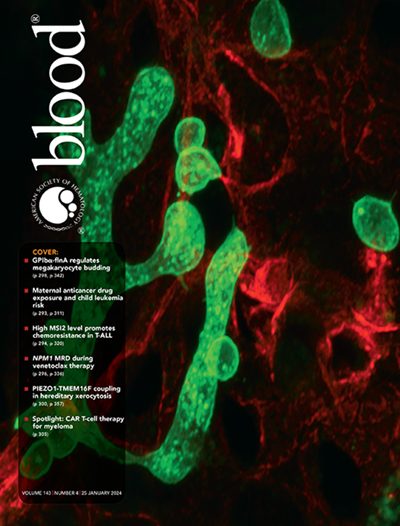XPO1驱动对依普那他普和阿扎胞苷的耐药,并可靶向tp53突变的髓系恶性肿瘤
IF 23.1
1区 医学
Q1 HEMATOLOGY
引用次数: 0
摘要
TP53突变骨髓增生异常综合征(MDS)和急性髓系白血病(AML)是最具侵袭性和化疗难治性的髓系肿瘤,中位总生存期小于6个月。开发新的治疗策略和了解对这种疾病的次优现有疗法的耐药机制存在巨大的未满足需求。在两项平行的2期临床试验中,我们观察到eprenetapopt联合阿扎胞苷治疗TP53突变的MDS/AML,完全缓解率为40-50%,分子缓解率为38%。然而,除非进行同种异体干细胞移植,否则复发不可避免。为了了解继发性耐药的机制,我们对序列临床试验样本进行了基因分型,在TP53突变的白血病细胞中进行了全基因组CRISPR筛选,并鉴定出XPO1是一种治疗上可处理的耐药介质。我们证明,在依普那他普和阿扎胞苷治疗后,XPO1在患者样本中过表达,阐明了这种情况发生的机制,并确定这是对联合治疗耐药的必要和充分条件。最后,我们在多种模型系统中验证了eprenetapopt与XPO1抑制剂联合可以克服这种耐药性,这为这种新的联合策略是TP53突变MDS/AML患者的可行治疗方法提供了临床前理论依据。本文章由计算机程序翻译,如有差异,请以英文原文为准。
XPO1 Drives Resistance to Eprenetapopt and Azacitidine and Can Be Targeted in TP53-Mutated Myeloid Malignancies.
TP53 mutated myelodysplastic syndrome (MDS) and acute myeloid leukemia (AML) are among the most aggressive and chemotherapy refractory myeloid neoplasms with a median overall survival of less than 6 months. An enormous unmet need exists to develop novel therapeutic strategies and understand resistance mechanisms to suboptimal existing therapies for this disease. In two parallel phase 2 clinical trials that combined eprenetapopt with azacitidine in TP53 mutated MDS/AML, we observed complete remission rates of 40-50% and molecular remission rates of 38%. However, unless allogeneic stem cell transplantation was performed, relapse inevitably occurred. To understand the mechanisms of secondary resistance responsible for this, we genotyped sequential clinical trial samples, conducted a genome-wide CRISPR screen in TP53 mutated leukemia cells, and identified XPO1 as a therapeutically tractable mediator of resistance. We demonstrate that XPO1 is overexpressed in patient samples after eprenetapopt and azacitidine treatment, elucidate the mechanism by which this occurs, and determine that it is necessary and sufficient for resistance to combination therapy. Finally, we validate in a variety of model systems including a novel patient derived xenograft model of TP53 mutant MDS, that eprenetapopt in combination with XPO1 inhibitors can overcome this resistance, providing preclinical rationale that this novel combination strategy is a viable therapeutic approach in TP53 mutant MDS/AML patients.
求助全文
通过发布文献求助,成功后即可免费获取论文全文。
去求助
来源期刊

Blood
医学-血液学
CiteScore
23.60
自引率
3.90%
发文量
955
审稿时长
1 months
期刊介绍:
Blood, the official journal of the American Society of Hematology, published online and in print, provides an international forum for the publication of original articles describing basic laboratory, translational, and clinical investigations in hematology. Primary research articles will be published under the following scientific categories: Clinical Trials and Observations; Gene Therapy; Hematopoiesis and Stem Cells; Immunobiology and Immunotherapy scope; Myeloid Neoplasia; Lymphoid Neoplasia; Phagocytes, Granulocytes and Myelopoiesis; Platelets and Thrombopoiesis; Red Cells, Iron and Erythropoiesis; Thrombosis and Hemostasis; Transfusion Medicine; Transplantation; and Vascular Biology. Papers can be listed under more than one category as appropriate.
 求助内容:
求助内容: 应助结果提醒方式:
应助结果提醒方式:


